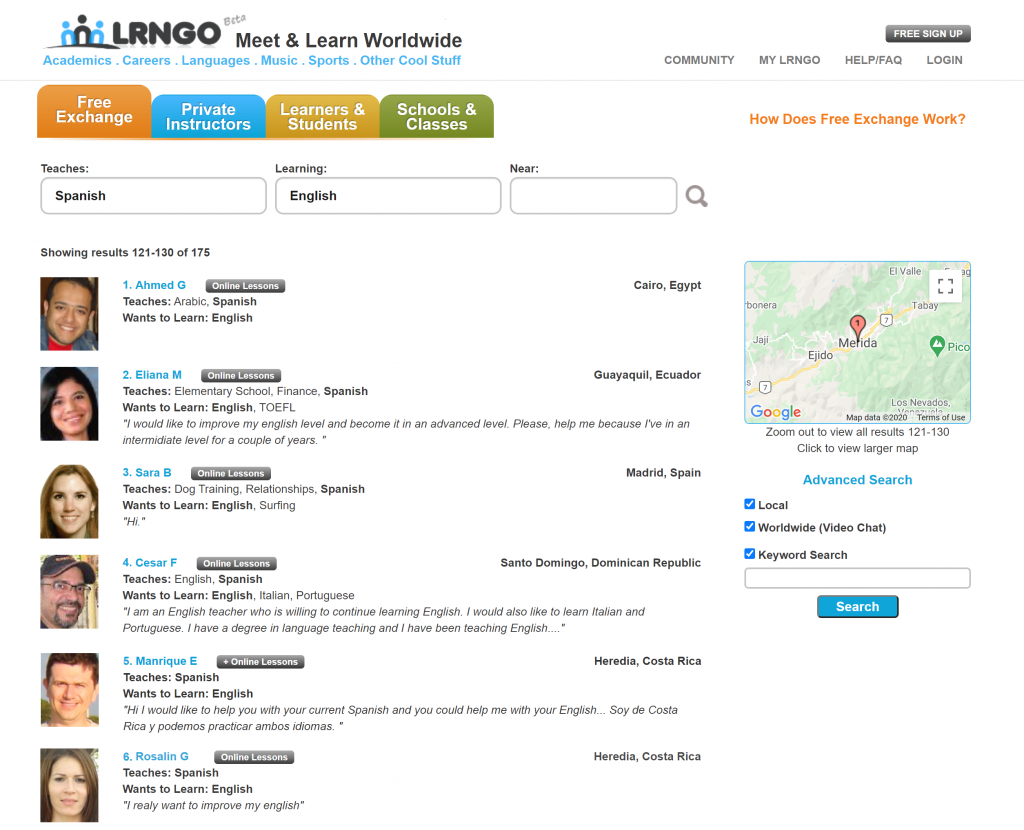The Time To Become An Online Tutor Is Now
(Updated 12/5/2020) It’s no secret that the coronavirus of 2020 has had a huge impact on the economy in general, and specifically on education. From school closings to parents dealing with taking over the role of teacher while they work from home, education-related challenges from dealing with COVID-19 will likely be talked about for years to come. However, with great adversity also comes great opportunity. Since in-person tutoring and teaching comes with significant health risks, an increasing number of parents and students have been opting for remote virtual tutoring to fill in the blanks. This is partly because remote learning from schools (public and private) results in a greater human disconnect and less personal attention from teachers, and partly because traditional schools and teachers (and students for that matter) weren’t built for remote learning environments. Most would agree that education wasn’t quite ready for this, and running large public and private schools completely virtually is still in the experimental stage.
on education. From school closings to parents dealing with taking over the role of teacher while they work from home, education-related challenges from dealing with COVID-19 will likely be talked about for years to come. However, with great adversity also comes great opportunity. Since in-person tutoring and teaching comes with significant health risks, an increasing number of parents and students have been opting for remote virtual tutoring to fill in the blanks. This is partly because remote learning from schools (public and private) results in a greater human disconnect and less personal attention from teachers, and partly because traditional schools and teachers (and students for that matter) weren’t built for remote learning environments. Most would agree that education wasn’t quite ready for this, and running large public and private schools completely virtually is still in the experimental stage.
So why is the time to start an online tutoring business now? The short answer is because there is a huge need. Students need one-to-one attention academically and psychologically, and parents need peace of mind knowing that their children are keeping up and staying engaged with school. Making a private tutor (or tutors) responsible for their childrens’ academic well-being has quickly become the most popular answer to this problem. But how do you start an online tutoring business? For teachers and tutors who have thus far only provided in-person services, the task may seem overwhelming with so many choices and variables. Don’t worry, it’s not as difficult as it sounds, and everyone feels that way in the beginning. Let’s break it down into ten easy steps.
Table of Contents
Become An Online Tutor In 10 Easy Steps
-
Step 1: Look into all of your options before starting your own online tutoring business
-
Step 2: Get the Necessary Hardware
-
Step 3: Choose a video communication service and accompanying software
-
Step 4: Get a PayPal or Other Online Payment Account
-
Step 5: Market Yourself
-
Step 6: Decide how much to charge for a session
-
Step 7: Examine the legal side of going into business for yourself
-
Step 8: Talk to other online tutors
-
Step 9: Getting used to working for yourself
-
Step 10: The Practice Run
How To Become an Online Tutor (Without Going Crazy)
-
How Online Tutoring Really Works
-
What About The Pay?
-
What’s With All The Cancellations?
Starting & Maintaining Your Online Tutoring Business
-
Expenses
-
Funding
-
Legal Stuff
Starting An Online Tutoring Business vs Working For An Online Tutoring Company
-
Your Own Online Tutoring Business (Working For Yourself)
-
Working For An Online Tutoring Company (Or All-In-One Tutoring Platform)
Will I Be Happy If I Become An Online Tutor?
Become An Online Tutor In 10 Easy Steps

Step 1: Look into all of your options before starting your own online tutoring business
There are few things to consider before making the big decision, and I’ll go through them one at a time
1. Going at it on your own is not the only option available. TeachersToGo.com; Eduboard.com; Tutor.com; tutorvista.com; there are many established online tutoring companies that allow you to work for them. Starting your own online tutoring business will require marketing, choosing your own payment system, and more. However, I hasten to add that none of these steps are insurmountable obstacles; in fact, as I hope to demonstrate, none of the steps are even particularly difficult. It is also important to keep in mind that tutoring companies and websites like the ones mentioned all charge a sizeable comission (generally from 20-60%). This means that you will make less money working as a tutor for one of these companies than if you successfully create your own thriving online tutoring business. To get more information on this subject, here are two superb websites to check out:
https://blog.tutorhub.com/2013/07/17/online-tutoring-a-do-it-yourself-guide-for-tutors/ – a good site to get both general information about tutoring, as well as recommendations for specific computer programs to use during your actual tutoring sessions.
https://www.usnews.com/education/find-online-tutor – this site provides a look at online tutoring from the customer’s perspective, including a detailed examination of the pros and cons of hiring a tutor from one of these tutoring sites.
2. It is also important to mention that there are a number of websites that are not quite tutoring websites, but still sites that you might be interested in. It is worth exploring the web to find the right fit for you. Here are two of these more esoteric options:
www.Fiverr.com – on Fiverr you create a “gig” and then post it on the site. For example, your “gig” could be an offer to help with math homework. If someone is interested in your services, they will contact you via the website. Upon successful completion of the “gig” for a client, you will be rewarded with $5 for your services; hence the name of the site. (This may be an issue when it comes to reasonable rates, but might be an ok place to practice.)
www.Guru.com – different from Fiverr because they list professional services at all prices and levels for both individuals and companies. This obviously means that the tasks that you are offering to complete must be more valuable.
3. One concern you might have is about the concept of online tutoring itself, the idea that online tutoring is simply not as effective as face-to-face. It is true that online tutoring has a negative side. For example, it limits the ability to observe what are called paralinguistic cues – ie: body movements, facial expressions, and other forms of “physical speaking” that communicate information nonverbally. It is important to remember, however, that such difficulties are not insurmountable; mainly all that is required is getting comfortable with having conversations via video. It is also important not to overlook the huge benefits other than simply health safety during a pandemic. For example, because tutoring online doesn’t require any of parties involved to travel, tutoring online is a huge timesaver. This means that new possibilities begin to emerge. Consider face to face tutoring for a moment: when both the teacher and the student have to spend time driving to a specific physical location, it doesn’t make sense to have a fifteen minute tutoring session because of the time lost in transit. In the online tutoring format, however, suddenly it becomes feasible to have these shorter, daily tutoring sessions.
Step 2: Get the Necessary Hardware
You will need a computer with a decent internet connection, a microphone, and a webcam. The internet connection should be broadband/high-speed internet with standard Cable or DSL if possible – with a speed of at least 800kbps at a bare minimum. Generally speaking, as far as the computer goes, most computers today come packaged with both a microphone and a webcam. However, you might want to replace both the packaged microphone and the webcam if they don’t perform well. In fact, since background noise can be an issue, you might seriously consider getting a headset (at least as a backup) rather than using the computer’s built in microphone and speakers.
If you are just starting out in online tutoring and need to purchase a computer, there are many affordable options to choose from, from refurbished systems to new desktops that are expressly built with the consumer on a budget in mind. The following is by no means a comprehensive list of sites, but simply a few of the many places to check out. It probably doesn’t need to be said, but make sure that, before you purchase anything, the system is capable of smoothly running video chatting applications. Just like the microphone and webcam, keep in mind that you now need a much higher level of performance since you will be using it for your business.
https://www.chicagotribune.com/consumer-reviews/sns-bestreviews-best-headphones-for-virtual-meetings-20200724-hpdrd5uicnap3bygieqxlg7nii-story.html– Some of the best and most reliable up to date headset choices for virtual use.
https://laptopswhizz.com/best-laptop-for-online-teaching/ – A great website for new computer choices following the familiar “Top 10” schema. We recommend getting a computer with at least 1.5 Ghz processor and a minimum of 2GB of RAM.
https://abc13.com/archive/8781766/ and https://www.pcmag.com/archive/why-you-should-buy-refurbished-computers-258050 – This pair of articles will begin to give you a basic understanding of the value of refurbished computers
https://www.pcmag.com/picks/the-best-budget-laptops – This is a good article to check out if you’re interested in specifically purchasing a laptop on a budget.
Step 3: Choose a video communication service and accompanying software
Determining a video chatting platform that you will use to communicate with your students is a crucial step. If you are just starting out as an online tutor, I would recommend either Zoom, Skype or Google Hangouts. All three are free, reliable, and easy to set up. Zoom, Google Hangouts and Skype also all allow easy integration with a variety of third party applications. Click on these links and follow the instructions to download any of the three.
Zoom: https://zoom.us/signup
Skype: https://www.skype.com/en/download-skype/skype-for-computer/.
Google Hangouts: https://hangouts.google.com/.
There are also numerous other video conferencing options to consider for online tutoring that are tailor-made for online tutoring with a lot of bells and whistles. Here are a few of the many other options available.
https://www.thelessonspace.com/ (not free)- this is a good alternative to skype or google hangouts. Users typically praise its reliability and wealth of collaborative features, which include application sharing, file sharing, and desktop sharing.
Facetime (free)- Although it only works between Apple products, Facetime is known for providing one of the best user experiences: it is easy to set up and the call quality is generally excellent. It may lack some of the collaborative features of some of the other widely known services though. In general, most online tutors work from a laptop or desktop, not a mobile device.
https://www.webex.com/ (free) – a full-fledged web conferencing solution offering features including desktop sharing and an interactive whiteboard.
On these video chatting platforms, there are a few other pieces and accompanying features you might need. Most of them will have an online whiteboard option, although some may charge a fee for that. A whiteboard acts as a teacher’s “virtual chalk board”, and is often important for tutoring. If your video chat does not include a whiteboard, https://scribblar.com/ is an independent, interactive and collaborative whiteboard that works with many platforms. It is a collaborative whiteboard that supports text chat.
Another feature that many tutors feel they need is screenshare. Screenshare with your student is a popular (and for some tutors an essential) feature. Most platforms support and include it. Occasionally, it will require a paid feature upgrade.
Lastly, most online tutors require file sharing options. Think of these as the online version of student worksheets, projects or workbooks in the classroom that the students might also take home for homework. The most well-known is probably Google docs (Free), which allows for multiple people to edit the same document at the same time and see the results in real-time.
To find more information on helpful software options, check out https://www.teachthought.com/featured/25-tutoring-tools-for-the-21st-century/. This site gives a dizzying number of various online products for teachers and tutors who are just starting their online tutoring business to consider.
Also https://www.goguardian.com/blog/technology/9-unique-ways-to-use-technology-in-the-classroom/ is a great source that helps teachers find ways to integrate technology into classrooms.
Lastly, https://www.capterra.com/tutoring-software/ provides reviews of many of the all-in-one online tutoring tools. (Be forewarned, most of these charge a monthly fee, and many of them take a significant chunk of your pay each time you charge your students. However, if they help bring you more work, it might be worth it.)
As a final note on the quickest path to become an online tutor and start your online tutoring business, it is worth spending time learning as much as you can about your video communication service of choice. Once you decide on your platform, you may have to guide your clients through the process of setting it up on their computers as well. In fact, if you want to optimize your chances of getting the most students possible, offer two or more of the most popular choices. (Many students tend to stick only to the ones they know, and may insist on not learning to use a new service or platform, but rather having you conform to theirs.) Zoom seems to be arguably the most common basic platform at this time. Even if it is not your main platform, it might not be a bad idea to have as a backup for students and/or parents who insist on using something they are familiar with.
Step 4: Get a PayPal or Other Online Payment Account
PayPal is probably the most well-known independent pay option available for online tutors. All that a client needs to make a payment is your email address. In order to make a payment, the client then goes to the PayPal website, clicks the “send” button on the top of the page, and then inputs the requisite information. Both you and they will receive an email confirmation recording the transaction. And that’s it. However, there are now many other online payment options out there as well. Zelle is becoming another popular choice if your students are local and live in the same city as you.
Some of the all-in-one tutoring platforms may include online payments in their monthly package, but again, they will take a significant portion of your pay to do so.
Regardless of how you decide to accept your online payments, here are a few things to take note of:
- You will want to make sure to get paid before the actual tutoring session. It will likely be difficult to track down clients after the sessions are completed.
- If you are using an independent online payment processor, you will want to create a “business” payment account with your processor as opposed to a “personal” account.
- Your earnings will be taxable.
So How Do I Become An Online Tutor With Students Worldwide?
FYI unfortunately, believe it or not, not every country accepts PayPal or any other single payment processor—not even the most popular. For those that don’t, here are a few alternatives:
Alipay: One of China’s leading online payment exchange solutions. Considering its reputation as the PayPal of the east, this is one to try if PayPal is not available in your online student’s country.
Skrill: Formally known as Moneybookers, this service has completely rebranded itself and is now known to be more reliable and efficient. It is also available in Pakistan, a country covered by neither Paypal nor Alipay.
Amazon Webpay: Operates almost exactly like PayPal. Easy to use, and simple to set up.
Step 5: Market Yourself
Marketing yourself can take a variety of forms. Here are a few options, in no particular order:
- Check out Google AdWords. For a fee, you can advertise directly on Google. Check out https://www.google.com for more information. This, of course, requires money up front, and is also very time consuming to learn. You also really have to be careful about setting the limits and watching your conversion rate, or you’ll spend way too much on leads that may not come through. Honestly, this can be a real money pit if you don’t know what you’re doing (and sometimes even when you do). There is a huge learning curve, so you might want to take a class or consult with a professional.
- Create a Facebook Presence – Create a Facebook profile at https://www.facebook.com/ and use it as an advertising platform to get the word out. Then join community groups that might be looking for your services and interact with them through Facebook. Check out the profiles of fellow tutors and see what the successful ones are doing to get an idea of what are acceptable and unacceptable forms of interacting and advertising in the Facebook community. Often times, you need to be more helpful in the beginning and subtle with regard to your advertising. For more information on using Facebook for free to promote your business, https://www.postplanner.com/surprising-ways-to-use-facebook-profile-for-marketing/ is a good place to start.
- Advertise on sites like Craigslist or Gumtree- at www.craigslist.org you can create adds advertising your tutoring service. For a detailed description of how to post ads on Craigslist, check out sites like https://www.wikihow.com/Sell-Items-on-Craigslist.
- Um, yeah…create a profile on Lrngo.com. Unlike other tutoring websites which take a fee for their marketing services, Lrngo is simply a medium through which thousands of people worldwide search to find, pay for and trade lessons with teachers & tutors, teachers and tutors who all keep 100% of their own pay. Go to www.lrngo.com to create a free profile. Because there are no fees, it also makes sense to link to the Lrngo profile from your Facebook, Craigslist and other advertising pages.
- Add your resume to the database of https://www.teacherstogo.com/teachercontact.html. There is no guarantee of work, but it costs you nothing to do this, and they will contact you if a student request or job opening comes in that looks like a good fit. Since the service is free and there is no obligation, you can easily accept or decline the student or job.
- Word of Mouth- The oldest form of advertising is one of the best. Very simply, people are more likely to pay attention when they are hearing an actual human speak rather than just reading words on a computer screen.
Don’t forget, at the end of the day, you choose who you are willing to teach. I would advise being very specific about the times you are willing to work and also about the clientele you are willing to work with.
Step 6: Decide how much to charge for a session
Online tutors generally charge between $25 and $80 an hour. As a proficient tutor just starting out in the online medium, it is often recommended to charge between $25 and $45. Of course, there is no hard and fast rule. Determining your price will take a little bit of research on your own part, examining, for example, how competitors are pricing their lessons. If you have a niche or tutor very advanced students in higher education, you may be able to charge more.
Step 7: Examine the legal side of going into business for yourself
For instance, in the U.S., if you are self-employed with earnings of more than $600, reporting your income by filing a 1099 tax return is required. It’s not hard to do this, but you may want to talk to your accountant. You can also get the basic information from the IRS if this is new to you, but they make it look more confusing than it needs to be.
Step 8: Talk to other online tutors
This is something that can never be emphasized enough. In order to really become effective at online tutoring, you’re going to want to learn as much as you can about it from talking with people who are respected in the field. While it is similar to face-to-face tutoring, it is obviously a different experience in a lot of ways. Talking to other online tutors and asking about how they made the transition from face-to-face tutoring to virtual tutoring is a great place to start.
Step 9: Getting used to working for yourself
This one can be a little harder than it initially sounds. Most people, having just started working for themselves, will be immensely productive because of the initial adrenaline rush for about two weeks or so. Then they will hit a so-called “unproductive slump”; the lack of deadlines and hard and fast appointments can be difficult to manage. Here a few brief tips to cope with the change.
- Stick to your schedule- This is a big one. I know that you feel like you can take a longer lunch break now than you used to and that you feel like you can now run errands during the workday. Resist the urge. Don’t procrastinate. Force yourself to meet your deadlines and stay on task.
- Have a definite end to your workday- This will not always be possible, but having a clear end of your workday will help you keep your sanity.
- Prioritize- Lots to do and no time to do it? Know which tasks on your agenda or most important and don’t let yourself be bogged down minor tasks. Brainstorming on a lesson plan that you need by the afternoon takes precedent over making a craigslist advertisement.
Step 10: The Practice Run
Still feeling a little nervous about the whole experience? I would recommend two things: 1) Try practicing by tutoring someone in your family or someone who is a friend. If you know someone in your family or circle of friends who wants to learn more about a skill or knowledge you have, teach them a lesson for a half hour or hour to start, then ask for feedback. Realize that this will be different than teaching someone you don’t know, but it can be a helpful place to start. 2) Sign up if you haven’t already and use the Free Exchange on LRNGO.com to make a match and practice with people who want to teach and learn from each other for free. As you probably know already, you can do this in person or online, and both experiences are valuable for learning, sharpening and refining tutoring and teaching skills. Here are two possible ways that LRNGO’s Free Exchange can help you practice.
- Use Lrngo to make a match and connect with someone who is interested in learning your subject of expertise, and who will teach you a subject that you want to learn in return. Are you interested in learning a little Spanish or figuring out how to solve a Rubik’s cube, or brushing up on your math skills? You can gain valuable teaching experience in exchange for free learning. For example, let’s say you are an English tutor who is interested in learning Spanish. Use the Free Exchange to contact someone who is interested in learning English but knows Spanish. You can then “exchange” languages. In other words, you will learn a skill you want to pick up, but you will also be able to practice teaching someone an expertise and gain valuable feedback and teaching experience.
- You can also use Lrngo’s Free Exchange as a resource to connect with others who are interested in getting better at online tutoring and arrange a quick meeting. Even though as a premise you are meeting to exchange learning, you can just as easily see that you are also exchanging “teaching.” In other words, while taking turns learning from each other, you can help each other with the goal of becoming better online tutors, exchanging online tutoring tactics, practicing together, and supporting each other.
In essence, use the Free Exchange on LRNGO as a chance to build up online teaching experience and practice without the pressure. Then when you’re ready, you can list as a Private Instructor for a fee. As with any skill, I can’t emphasize enough how beneficial practice is to improving your tutoring ability and calming your nerves.
Remember to always ask the student about his or her goals and reasons for learning at the first lesson (or before). A good tutor or teacher will want to stay focused on how he or she can best help the student, and it’s helpful to know about the student’s expectations and why he or she wants to learn the subject. In the end, the result of helping someone learn and improve should be no different on video chat than it is in person.
How To Become an Online Tutor (Without Going Crazy)
Ok you’ve read this far, so it’s likely you are seriously considering putting some time into this. Maybe you already have real teaching or tutoring experience, but have not yet done so online. Or perhaps you tried it a while back, but at that time there was too much of a disconnect from physically teaching or tutoring in the real world. Or maybe you are an expert in a particular subject or skill, and you have just always wanted to do this and never tried. Regardless, here’s the real deal:
How Online Tutoring Really Works
Like any other worthwhile job or endeavor, at first there will be a lot of new information to get used to. In the beginning, even if your skills are excellent, it can be difficult to break in and get students with so much competition. Here is some practical advice from experienced online tutors, including the stuff they don’t tell you on the all-in-one tutoring sites when they try to get you to join either for a monthly fee or a percentage of your pay.
Marketing Is Hard
Think about it: I am a parent or student looking for tutors. I see your advertisement along with many others. Some of them don’t look all that great, but many of them do. In fact, many of them look as good as yours. Some prices are the same or similar, and some of them have a lot of positive reviews from other parents and students. How do I know which one to pick? The answer is clear; I don’t. Here’s the hard truth – being good at what you do and convincing others you are good at what you do are two different things. It’s easy to say this, but really understanding it is one of the keys to marketing. Before you can even deliver your amazing service, you have to convince someone that it is, in fact, an amazing service. Here is an article about how to compete with other profiles on a tutoring site when you first become an online tutor.
Know Your Audience
You may want to start with a subject or niche of subjects that you have the most experience with and that you are strongest in. You can always branch out later from there. At the very least, you should lead with and put the subject categories that you have the best chance of parents and students hiring you to tutor first. Try to put yourself in the mind of a parent or student looking for tutors who is a specialist and can really help with those subjects. Then think about what your potential clients (ie: parents and students) want to hear from you. Make yourself appear friendly and approachable, yet confident that you can help and good at what you do. You have to appear to add more value than just a standard tutor.
Selling Your Reputation
There is a famous saying, “It takes a lifetime to build a reputation and one day to ruin it.” Start your advertising by talking about your credentials and/or experience. If you have any former students you have helped in the past, ask if they will give you an endorsement. You can put it on your own website if the student or parent allows you to use their name, or you can ask them to use third party reviewers like Google or Yelp, etc.
Then each time you are sure you have helped, ask your students to give you reviews. Try to gage if they are happy or you may receive negative public feedback. Even better, always communicate with the student and try to mitigate how to improve the student’s experience as you go. If a student seems to feel that something is not going well, it is much better to lose a student who is not a good fit than to keep going and waste their time and yours. Remember, the last thing you want is a student who is angry or who feels like they were taken advantage of.
Occasionally, you may have a student who is an unreasonable person, but this is actually very rare. In this case, drama will follow them wherever they go, and it will show in their reviews and comments on social media and elsewhere. There are some sites where students can directly leave reviews on your tutoring profile. Overall, this can be a good thing, but you will have to manage it accordingly.
Becoming An Online Tutor People Trust
Make sure you respond to requests from new potential clients and current students quickly. You may want to set up your email or cellphone text messaging to notify you when a request or question from a student comes in. At least, remember to check on a daily basis. Also take care to document and try to keep track of the time zone of all potential clients and students. In case you receive a message from any enquiring or current student, try to be as helpful to them as possible. This will pay off in the long run. Having said that, if messages and questions from current students outside of paid tutoring time are getting out of hand, you may have to set some boundaries. It should be understood that you can
What About The Pay?
There are two schools of though on this. One is that you shouldn’t charge less than you’re worth or sell yourself short. If someone doesn’t pay the amount you think you are worth, you will pass until you find a client who will. The other is that you can charge a lower rate to get more students at first, then change your rates later incrementally and ask for more as you build up clientele. Both points are actually valid, and you need to find the right balance for you.
If you do decide to raise your price later, I would NOT recommend doing so with current students if you can help it. You can notify them that the price will be higher for new students (and this would include them if they discontinue and then try to come back), but let them know that you will not change their price since it was already agreed. Clients will not appreciate a tutor who raises the price for their services intermittently, and they may no longer trust you.
What’s With All The Cancellations?
Cancellations can be a big friction point if you are working for an online tutoring company. Many online tutoring companies are notorious for not compensating online tutors for last minute cancellations and no shows. You will also want to make sure that any all-in-one tutor platforms you might use have a solution for this as well. Most successful tutors have some kind of cancellation policy, and I would recommend that you have either a same day policy or 24 hours notice. (A same day cancellation policy is easier to enforce.)
A same day cancellation policy simply means that you have an agreement with the client where they understand that if they reschedule or cancel on the same day as the previously scheduled session (or don’t show up), there will be no rescheduled lesson or credit or refund. Of course, you can always make an exception if someone is seriously injured or there is an unforeseen event that would make you feel bad if you charge them for cancelling at the last minute. However, these occurrences would be rare, and most clients will understand that there is a big difference between cancelling because they are in the hospital as opposed to forgetting that they have a lesson.
Advance notice cancellations on the other hand are not usually a problem, and it may seem unreasonable to clients (parents and students) if you will not reschedule when they give you enough notice in advance. The other caveat to having a cancellation policy is that it will seem unreasonable if it is one-sided. For instance, it will be much harder to enforce a same day cancellation policy if you cancel a session the same day with the client. It should go without saying that you should never charge or refuse to refund a session that you have cancelled yourself. Consistency is important (see Selling Your Reputation).
Starting & Maintaining Your Online Tutoring Business

You likely won’t need a formal business plan, unless you plan to ask for investment or a business loan. That doesn’t mean you shouldn’t outline and put together a general informal plan though to keep track of things. You probably should so you can continuously assess where you are and how things are going. You don’t have to put a lot of time into an informal plan, you just have to outline your goals and check it regularly. This can help you make the best business (and life) decisions possible. There is a saying in business: the business plan (meaning how accurate it will be) is worthless, but the planning itself is essential.
Expenses
You likely won’t need a whole lot of money to get started, but you should write down and budget all of your expenses. Then compare that amount regularly to the amount of money you have made. Simple concept, but I’m always amazed by how many people don’t do this. You have to have some measurement to decide and evaluate how things are going in order to prioritize. Most often I’ve seen a lot of money in the beginning go to advertising, but you really have to be careful about this spend. It’s best to run small advertising experiments at first and measure the amount of return. If they bring you a little bit more students and money than you spent, then you can increase that advertising incrementally and measure again. Take some time to check how your business is doing weekly and monthly, then document and reassess.
Funding
You likely won’t be getting business funding from a bank or an external source for online tutoring. (Again, you might need a formal business plan if you are.) For startup costs, most online tutors begin by using their personal savings. If you don’t have much in the way of assets, you might want to try working for an online tutoring company or signing up on an all-in-one platform that takes a percentage of your pay at first. Then when you start making enough money, you can invest more to start your own online tutoring business. Then you can become independent and advertise to make more money for yourself. (Keep reading below and see Starting An Online Tutoring Business vs Working For An Online Tutoring Company to assess the pros and cons.)
If you don’t use personal savings, you could elect to pay for startup costs using a credit card. In fact, you may be able to get a credit card specifically for your online tutoring business. If so, this can help separate business costs from personal. The interest rates may or may not be as good though. You may also have the option of a personal loan. Be careful if you need to put up collateral. (It’s good advice not to borrow more than you can afford to lose.)
Legal Stuff
You will likely not be tutoring under a company name, or if you will, at least not in the beginning. Most online tutors just use their own name, and this actually has advantages when promoting yourself on social media. It is a lot more authentic when you reveal your actual personality traits and that you are a real person when you promote yourself. If for some reason you don’t want to do this, it will likely be more expensive and difficult to promote yourself as a new company.
If you would rather do business as a company instead, you will need to file a dba (doing business as) for your tutoring business name. Some cities require filing locally, but in some areas you can just file with the Secretary of State. If you use a business name, you will also need to file business papers of formation to register it (usually as an LLC or sole proprietorship). Lastly, you will need to do a trademark search www.uspto.gov to make sure it is not already taken. If it is not, then you will need to register the name as a trademark too. You may want to hire a trademark attorney to do this. It should cost between $400-$900 for all of the trademark registration if there are no hiccups and no one contests it. At the end of the day, there is not much advantage to using a business name rather than your own name when becoming an online tutor, unless you are working together with other tutors instead of alone.
Starting An Online Tutoring Business vs Working For An Online Tutoring Company

To work for yourself or work for a company: that is the question. When thinking about how to become an online tutor, this will be one of your first and most important decisions. There are advantages and disadvantages to both. In fact, at different times in their lives, many online tutors might gravitate toward one option, and then the other depending on their many circumstances at the time.
Keep in mind that many of the all-in-one online tutoring platforms also operate a lot like online tutoring companies, even though they don’t officially employ you. They still either require that you pay them a monthly fee, or they take a percentage of each lesson payment you receive. (You will need to see how much.) They also require that you conform to their rules and Terms. Below are some pros and cons to help you assess whether working for yourself or working for an online tutoring company is the right choice for you.
Your Own Online Tutoring Business (Working For Yourself)
Pros
- Keep All Of Your Pay
- You Choose Tutoring Platform & Software
- Can Use Multiple Platforms
- Make Your Own Rules
- Decide How Much You Charge
- Set Your Own Schedule
- Decide Which Students To Accept
Cons
- Must Do Your Own Marketing/Advertising
- More Challenging At First To Find Students
- Spend More Time On Administration
- Takes Longer To Learn What Works
Working For An Online Tutoring Company (Or All-In-One Tutoring Platform)
Pros
- Easier To Get New Students
- They Usually Advertise For You
- Everything Is Already Set Up
- Less Time On Administration
- Provide Help To Learn Everything
Cons
- Make Less Money
- They Decide How Much To Charge (Or Take A Percentage)
- Have To Follow Their Rules & Terms
- They Decide The Hours (Or You Use Their Scheduling)
- Don’t Have A Choice Which Students You Accept
- Usually Have To Wait To Be Paid
Will I Be Happy If I Become An Online Tutor?
Do you like working from the comfort of your home? Does staying risk free during the COVID-19 pandemic while you make money at home sound appealing? Does working in your pajamas sound like your dream job? (Well ok, you really need to wear a shirt, but conceivably, you could stay in your pajamas from the waist down!) Tutoring is one of the most rewarding and profitable small businesses, and one of the least costly to start. If you follow the steps above and ask advice often from others who have done it, it won’t be long before you become a successful online tutor, and you might even have fun doing it.



 I’ll save you the suspense. The answer is None of the Above.
I’ll save you the suspense. The answer is None of the Above.